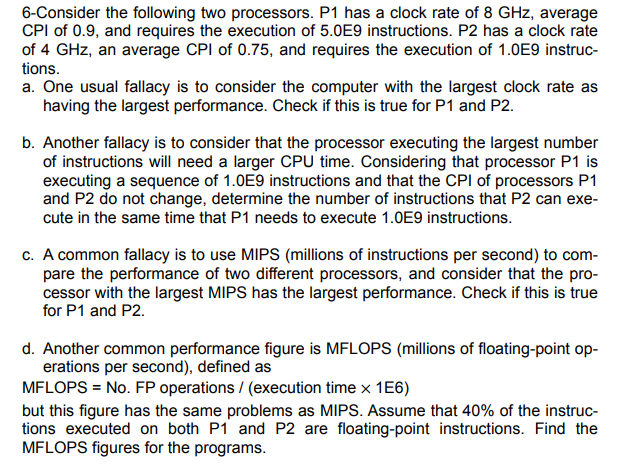6-Consider the following two processors. P1 has a clock rate of 8 GHz, average CPI of 0.9, and requires the execution of 5.0E9 instructions. P2 has a clock rate of 4 GHz, an average CPI of 0.75, and requires the execution of 1.0E9 instruc- tions. a. One usual fallacy is to consider the computer with the largest clock rate as having the largest performance. Check if this is true for P1 and P2. b. Another fallacy is to consider that the processor executing the largest number of instructions will need a larger CPU time. Considering that processor P1 is executing a sequence of 1.0E9 instructions and that the CPI of processors P1 and P2 do not change, determine the number of instructions that P2 can exe- cute in the same time that P1 needs to execute 1.0E9 instructions. c. A common fallacy is to use MIPS (millions of instructions per second) to com- pare the performance of two different processors, and consider that the pro- cessor with the largest MIPS has the largest performance. Check if this is true for P1 and P2. d. Another common performance figure is MFLOPS (millions of floating-point op- erations per second), defined as MFLOPS = No. FP operations / (execution time x 1E6) but this figure has the same problems as MIPS. Assume that 40% of the instruc- tions executed on both P1 and P2 are floating-point instructions. Find the MFLOPS figures for the programs.
6-Consider the following two processors. P1 has a clock rate of 8 GHz, average CPI of 0.9, and requires the execution of 5.0E9 instructions. P2 has a clock rate of 4 GHz, an average CPI of 0.75, and requires the execution of 1.0E9 instruc- tions. a. One usual fallacy is to consider the computer with the largest clock rate as having the largest performance. Check if this is true for P1 and P2. b. Another fallacy is to consider that the processor executing the largest number of instructions will need a larger CPU time. Considering that processor P1 is executing a sequence of 1.0E9 instructions and that the CPI of processors P1 and P2 do not change, determine the number of instructions that P2 can exe- cute in the same time that P1 needs to execute 1.0E9 instructions. c. A common fallacy is to use MIPS (millions of instructions per second) to com- pare the performance of two different processors, and consider that the pro- cessor with the largest MIPS has the largest performance. Check if this is true for P1 and P2. d. Another common performance figure is MFLOPS (millions of floating-point op- erations per second), defined as MFLOPS = No. FP operations / (execution time x 1E6) but this figure has the same problems as MIPS. Assume that 40% of the instruc- tions executed on both P1 and P2 are floating-point instructions. Find the MFLOPS figures for the programs.
Computer Networking: A Top-Down Approach (7th Edition)
7th Edition
ISBN:9780133594140
Author:James Kurose, Keith Ross
Publisher:James Kurose, Keith Ross
Chapter1: Computer Networks And The Internet
Section: Chapter Questions
Problem R1RQ: What is the difference between a host and an end system? List several different types of end...
Related questions
Question

Transcribed Image Text:6-Consider the following two processors. P1 has a clock rate of 8 GHz, average
CPI of 0.9, and requires the execution of 5.0E9 instructions. P2 has a clock rate
of 4 GHz, an average CPI of 0.75, and requires the execution of 1.0E9 instruc-
tions.
a. One usual fallacy is to consider the computer with the largest clock rate as
having the largest performance. Check if this is true for P1 and P2.
b. Another fallacy is to consider that the processor executing the largest number
of instructions will need a larger CPU time. Considering that processor P1 is
executing a sequence of 1.0E9 instructions and that the CPI of processors P1
and P2 do not change, determine the number of instructions that P2 can exe-
cute in the same time that P1 needs to execute 1.0E9 instructions.
c. A common fallacy is to use MIPS (millions of instructions per second) to com-
pare the performance of two different processors, and consider that the pro-
cessor with the largest MIPS has the largest performance. Check if this is true
for P1 and P2.
d. Another common performance figure is MFLOPS (millions of floating-point op-
erations per second), defined as
MFLOPS = No. FP operations / (execution time x 1E6)
but this figure has the same problems as MIPS. Assume that 40% of the instruc-
tions executed on both P1 and P2 are floating-point instructions. Find the
MFLOPS figures for the programs.
Expert Solution
This question has been solved!
Explore an expertly crafted, step-by-step solution for a thorough understanding of key concepts.
This is a popular solution!
Trending now
This is a popular solution!
Step by step
Solved in 5 steps with 4 images

Recommended textbooks for you

Computer Networking: A Top-Down Approach (7th Edi…
Computer Engineering
ISBN:
9780133594140
Author:
James Kurose, Keith Ross
Publisher:
PEARSON

Computer Organization and Design MIPS Edition, Fi…
Computer Engineering
ISBN:
9780124077263
Author:
David A. Patterson, John L. Hennessy
Publisher:
Elsevier Science

Network+ Guide to Networks (MindTap Course List)
Computer Engineering
ISBN:
9781337569330
Author:
Jill West, Tamara Dean, Jean Andrews
Publisher:
Cengage Learning

Computer Networking: A Top-Down Approach (7th Edi…
Computer Engineering
ISBN:
9780133594140
Author:
James Kurose, Keith Ross
Publisher:
PEARSON

Computer Organization and Design MIPS Edition, Fi…
Computer Engineering
ISBN:
9780124077263
Author:
David A. Patterson, John L. Hennessy
Publisher:
Elsevier Science

Network+ Guide to Networks (MindTap Course List)
Computer Engineering
ISBN:
9781337569330
Author:
Jill West, Tamara Dean, Jean Andrews
Publisher:
Cengage Learning

Concepts of Database Management
Computer Engineering
ISBN:
9781337093422
Author:
Joy L. Starks, Philip J. Pratt, Mary Z. Last
Publisher:
Cengage Learning

Prelude to Programming
Computer Engineering
ISBN:
9780133750423
Author:
VENIT, Stewart
Publisher:
Pearson Education

Sc Business Data Communications and Networking, T…
Computer Engineering
ISBN:
9781119368830
Author:
FITZGERALD
Publisher:
WILEY